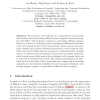Free Online Productivity Tools
i2Speak
i2Symbol
i2OCR
iTex2Img
iWeb2Print
iWeb2Shot
i2Type
iPdf2Split
iPdf2Merge
i2Bopomofo
i2Arabic
i2Style
i2Image
i2PDF
iLatex2Rtf
Sci2ools
IPMI
2005
Springer
2005
Springer
Approximating Anatomical Brain Connectivity with Diffusion Tensor MRI Using Kernel-Based Diffusion Simulations
We present a new technique for noninvasively tracing brain white matter fiber tracts using diffusion tensor magnetic resonance imaging (DT-MRI). This technique is based on performing diffusion simulations over a series of overlapping three dimensional diffusion kernels that cover only a small portion of the human brain volume and are geometrically centered upon selected starting voxels where a seed is placed. Synthetic and real DT-MRI data are employed to demonstrate the tracking scheme. It is shown that the synthetic tracts can be accurately replicated, while several major white matter fiber pathways in the human brain can be reproduced noninvasively as well. The primary advantages of the algorithm lie in the handling of fiber branching and crossing and its seamless adaptation to the platform established by new imaging techniques, such as high angular, q-space, or generalized diffusion tensor imaging.
Diffusion Tensor | Dimensional Diffusion Kernels | IPMI 2005 | Medical Imaging | White Matter Fiber |
| Added | 16 Nov 2009 |
| Updated | 16 Nov 2009 |
| Type | Conference |
| Year | 2005 |
| Where | IPMI |
| Authors | Jun Zhang, Ning Kang, Stephen E. Rose |
Comments (0)

